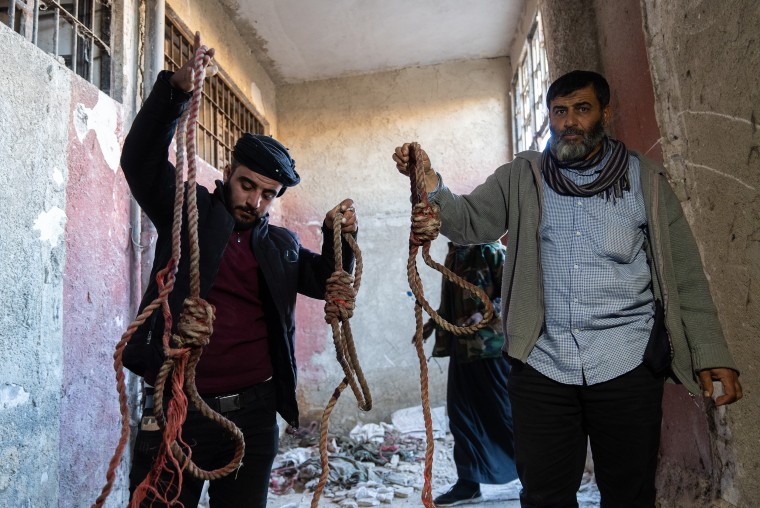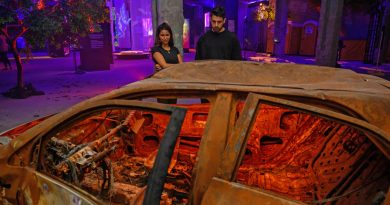Syria’s celebrations muted by evidence of torture in Assad’s notorious prisons
DAMASCUS, Syria — In the outskirts of Syria’s capital Tuesday, the hope of a country freed from its longtime dictator was muddled with the emerging horrors of the Assad regime.
Thousands of people were rushing to labyrinthine prisons, searching for any trace of loved ones they feared had disappeared into their unseen depths.
The most notorious gulag lies in the barren, rocky hills outside the capital, Damascus. Saydnaya military prison is a dungeon of tiny, concrete cells nicknamed “the human slaughterhouse.” NBC News went there Tuesday and found evidence of barbaric conditions — as well as the desperation of Syrians searching for their loved ones.
During the Assad family’s 50-year rule, a network of facilities like Saydnaya were patrolled by armed guards, ensuring those who went in could not come out. The regime used the prisons to detain, torture and kill tens of thousands of Syrians, some for criticizing the government or other trumped-up allegations, according to rights groups, whistleblowers and global officials.

Now, with Bashar al-Assad and his enforcers gone, the tree-lined entrance to Saydnaya is packed with hundreds, perhaps thousands, of cars. People have come from all over Syria to see if their loved ones are still inside, partly motivated by rumors of a secret wing detaining starving captives
They came armed with pry bars, pickaxes and their bare hands. At one point a bulldozer showed up, all to hack away at the jail’s edifice in the hope of revealing a hidden cache of abductees.
Outside the building itself — a hulking, brutalist cube in dilapidated off-white — crowds of mostly men gathered, some of them shouting to ask whether anyone had seen their sons, brothers or uncles believed detained by the regime. One of these men, a self-appointed organizer, called out names from a filthy document apparently recovered from one of the administrative rooms.
These documents littered the floor, a concern for international legal scholars who have stressed the importance of maintaining these records for use as evidence of these crimes.

These places were not secret, but well known among Syrians, documented by rights groups and widely reported in the news media. Nevertheless, Tuesday brought a tableau of intense emotions, with people crying and screaming as they saw behind the curtain of their toppled police state for the first time.
Inside, concrete cells with white open bars were large enough to accommodate four people at most — but from the detritus appeared to have been crammed with dozens. Piles of clothes and bedrolls were lit by the smartphone flashlights of civilians combing the decaying maze for clues.
One woman said her son had been missing for a decade. He was accused of being a militant; she said he was a nurse.
In one room stood a large, iron device comprising two flat surfaces, large enough to fit a prisoner, and a mechanism to close them tight. People here called it the “execution press” — used to crush inmates to death or to torture them.
Another room featured a large metal pole stretching from one wall to the other. Prisoners would apparently be handcuffed to this with their feet off the ground and beaten. Outside, a man held at least four nooses, one covered in blood, that he said were used to put people to death.

When the Syrian rebels seized Damascus on Sunday, they said they freed dozens of prisoners from Saydnaya, with video appearing to show women reluctant to leave their cells, so disbelieving were they that the tyrant who held them had been ousted.
Rumors that the prison contained a secret underground “red wing” drew crowds of more families, as well as the White Helmets search and rescue organization, which dispatched its crews to look for such a hidden complex.
Around 1:30 a.m. local time (5:30 p.m. ET Monday), the White Helmets said there was no evidence of any hidden chamber or rooms, sharing the “profound disappointment of the families of the thousands who remain missing and whose fates remain unknown.”

Nevertheless, people were still using hand tools to knock through sections of floors and walls, presumably still looking for hatches or doors, when NBC News visited Tuesday.
Saydnaya may be the most infamous but it is far from the only place where Assad and Hafez Assad, his predecessor and father, visited the darkest horrors upon their own people. The dynasty built and operated a network of detention centers scattered across Syria, according to the human rights group Amnesty International.
The Human Rights Data Analysis Group, an independent scientific human rights organization based in San Francisco, has counted at least 17,723 people killed in Syrian custody from 2011 to 2015 — around 300 every week — almost certainly a vast undercount, it says.
Prisoners in Saydnaya “are regularly tortured, usually through severe beatings and sexual violence,” Amnesty International said in a landmark 2017 report, which drew on survivors’ accounts and other sources. “They are denied adequate food, water, medicine, medical care and sanitation, which has led to the rampant spread of infection and disease.”
Even during these torture sessions, total “silence is enforced,” it said, contributing to “many detainees” developing “serious mental illnesses such as psychosis.” All of this seemed “designed to inflict maximal physical and psychological suffering. Their apparent goal is to humiliate, degrade, dehumanize and to destroy any sense of dignity or hope,” it said.

Hafez Assad began this policy of systematic and secretive state violence in the 1980s, making an estimated 17,000 Syrians disappear between then and 2000, Amnesty said. But the “government’s violations against detainees have increased drastically in magnitude and severity” since 2011, it added.
That was the year Syrians began peacefully protesting against the regime as part of the The younger Assad violently crushed the demonstrators, leading to the armed uprising that became the civil war.
The conflict has seen more than 350,000 deaths documented by the United Nations, which says this is “certainly an undercount.” Now, Syrians hope their country can transition to something that does not involve such loss nor the abuses meted out at Saydnaya.
Richard Engel and Gabe Joselow reported from Damascus, and Alexander Smith from London.




